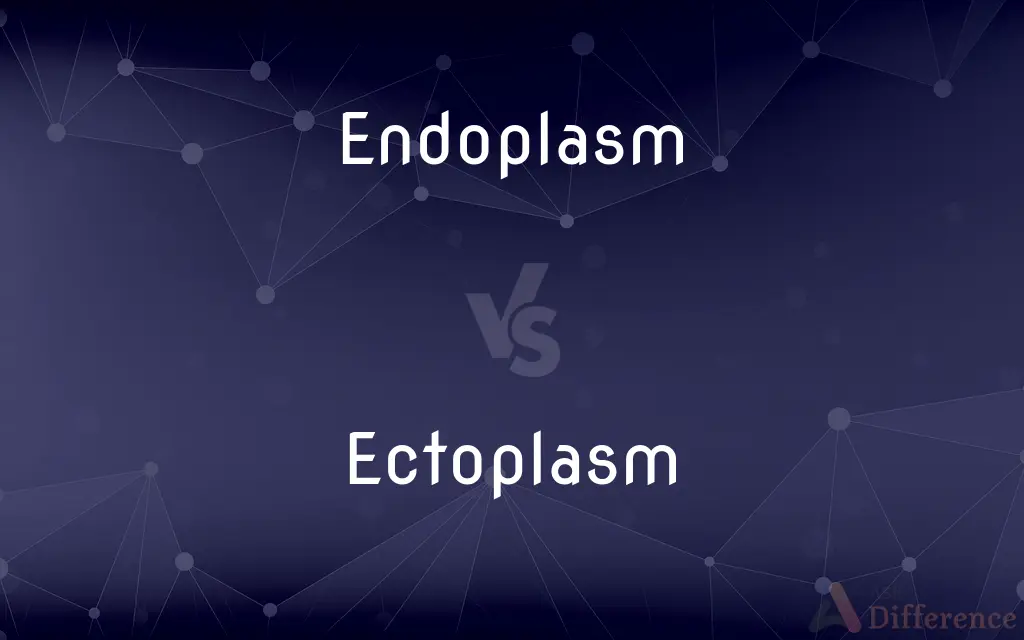Endoplasm vs. Ectoplasm — What's the Difference?
By Urooj Arif & Fiza Rafique — Updated on April 17, 2024
Endoplasm is the inner, more fluid component of the cytoplasm, whereas ectoplasm is the outer, more gel-like layer in certain cells.

Difference Between Endoplasm and Ectoplasm
Table of Contents
ADVERTISEMENT
Key Differences
Endoplasm, located towards the interior of the cell, is characterized by its fluid, granular consistency which facilitates the movement and mixing of organelles and molecules within the cell. On the other hand, the ectoplasm forms the outer layer of the cytoplasm and is generally more gel-like and structured, playing a crucial role in cellular shape and protection.
The endoplasm houses most of the cell's functional components, including the nucleus, mitochondria, and various other organelles necessary for the cell's metabolism and reproduction. Whereas the ectoplasm often contains fewer organelles and is primarily involved in interactions with the cell's external environment, such as movement and interaction with adjacent cells.
Endoplasmic movement is typically more dynamic due to its fluid nature, assisting in the distribution and functioning of cellular components. Conversely, the ectoplasm serves as a more stable framework that supports cellular structure and provides a barrier against external forces.
In some cells, especially amoeboid types, the endoplasm can flow forwards, filling the ectoplasm which then forms a pseudopod used for locomotion and feeding. In contrast, the ectoplasm maintains the cell’s integrity during such movements by becoming the site of interaction with the external environment.
The differences in consistency and function between endoplasm and ectoplasm are essential for cellular responses to environmental stimuli and for maintaining internal organization. While the fluid-like endoplasm allows for flexibility and internal transport, the viscous ectoplasm ensures structural stability and protection.
ADVERTISEMENT
Comparison Chart
Consistency
Fluid and granular
Gel-like and structured
Location
Inner portion of the cytoplasm
Outer layer of the cytoplasm
Function
Houses organelles, aids in movement
Provides structural support
Role in Movement
Moves within the cell
Forms pseudopods for locomotion
Interaction
Primarily internal
Interacts with external environment
Compare with Definitions
Endoplasm
The inner, fluid-like part of the cytoplasm in a cell where most organelles are found.
The endoplasm of the cell was active with transporting nutrients.
Ectoplasm
Helps in forming pseudopods in amoeboid cells for movement and feeding.
Amoebas extend their ectoplasm to form pseudopods that help them move and capture food.
Endoplasm
Characterized by its fluid consistency, allowing for the easy movement of components.
The fluid nature of the endoplasm facilitates efficient organelle movement.
Ectoplasm
Provides structural support and plays a role in cellular interactions.
The cell’s ectoplasm helps maintain its shape during movement.
Endoplasm
Functions as the site for most metabolic processes within the cell.
Cellular respiration primarily occurs within the endoplasm.
Ectoplasm
The outer, more gelatinous layer of the cytoplasm in certain cells.
The ectoplasm forms a protective barrier against the external environment.
Endoplasm
More granular and dense compared to its outer layer.
The granular texture of the endoplasm is due to the high concentration of organelles.
Ectoplasm
Contains fewer organelles and is involved in the cell’s interactions with its surroundings.
The ectoplasm is crucial for the cell's locomotive and defensive strategies.
Endoplasm
Essential for cellular processes such as growth, replication, and response to stimuli.
The endoplasm reacts dynamically to changes in the cell's environment.
Ectoplasm
Acts as a semi-solid barrier to protect the cell’s more fluid inner environment.
The gel-like ectoplasm is essential for cellular integrity under stress.
Endoplasm
Endoplasm generally refers to the inner (often granulated), dense part of a cell's cytoplasm. This is opposed to the ectoplasm which is the outer (non-granulated) layer of the cytoplasm, which is typically watery and immediately adjacent to the plasma membrane.
Ectoplasm
(Biology) The outer portion of the continuous phase of cytoplasm of a cell, sometimes distinguishable as a somewhat rigid, gelled layer beneath the cell membrane.
Endoplasm
A central, less viscous portion of the cytoplasm that is distinguishable in certain cells, especially motile cells.
Ectoplasm
The substance believed to be the transparent corporeal presence of a spirit or ghost.
Endoplasm
(cytology) The inner portion of the cytoplasm of a cell
Ectoplasm
(parapsychology) An immaterial or ethereal substance, especially the transparent corporeal presence of a spirit or ghost.
Endoplasm
The protoplasm in the interior of a cell.
Ectoplasm
(cytology) The outer granule-free layer of cytoplasm.
Endoplasm
The inner portion of the cytoplasm of a cell
Ectoplasm
The outer transparent layer of protoplasm in a developing ovum.
Ectoplasm
(spiritualism) a substance supposed to emanate from the body of the medium during a trance
Ectoplasm
The outer granule-free layer of cytoplasm
Common Curiosities
How does ectoplasm contribute to a cell's structure?
Ectoplasm provides structural support, maintaining the cell's shape and protecting internal components from external forces.
Why is ectoplasm less active in organelle content?
Ectoplasm is structured to be more involved in physical and protective roles rather than metabolic activities, hence it contains fewer organelles.
What would happen if a cell lacked ectoplasm?
Without ectoplasm, a cell might be less able to maintain its shape and protect itself from mechanical stress.
Can the properties of endoplasm change?
Yes, the properties of endoplasm can change, becoming more or less fluid depending on the cell's metabolic needs and external conditions.
Is ectoplasm visible under a microscope?
Yes, ectoplasm can be observed under a microscope, often appearing as a clear, thicker layer around the cell.
What are the visual differences between ectoplasm and endoplasm?
Under a microscope, ectoplasm appears denser and more gel-like, while endoplasm is more fluid and granular.
What is the main function of endoplasm?
The endoplasm primarily functions as the site for metabolic activities and houses most cellular organelles.
What cells typically have a distinct ectoplasm and endoplasm?
Amoeboid cells, such as amoebas, typically exhibit a clear distinction between ectoplasm and endoplasm, which aids in their movement and feeding.
How do environmental changes affect ectoplasm?
Ectoplasm can become more rigid or fluid in response to environmental conditions, adapting to protect the cell or facilitate movement.
How do the roles of endoplasm and ectoplasm differ in cellular response to stimuli?
Endoplasm reacts dynamically to internal stimuli by facilitating metabolic reactions, whereas ectoplasm primarily interacts with external environmental changes.
How does endoplasm assist in cell division?
Endoplasm plays a crucial role in cell division by ensuring the proper distribution of organelles and genetic material between daughter cells.
Do all cells have a distinct ectoplasm and endoplasm?
Not all cells have a clear distinction; this feature is more pronounced in cells like amoebas that need to move and capture prey.
Can the functions of ectoplasm and endoplasm overlap?
While their primary functions are different, there can be some overlap in roles, especially in stress responses and environmental interactions.
How do temperature changes affect the consistency of endoplasm?
Temperature increases can make the endoplasm more fluid, enhancing metabolic activities, while decreases might slow down these processes.
What evolutionary advantages does the division of ectoplasm and endoplasm provide?
This division allows cells to manage internal functions efficiently while interacting effectively with their external environment.
Share Your Discovery

Previous Comparison
Grammatic vs. Grammatical
Next Comparison
Awakening vs. WakeningAuthor Spotlight
Written by
Urooj ArifUrooj is a skilled content writer at Ask Difference, known for her exceptional ability to simplify complex topics into engaging and informative content. With a passion for research and a flair for clear, concise writing, she consistently delivers articles that resonate with our diverse audience.
Co-written by
Fiza RafiqueFiza Rafique is a skilled content writer at AskDifference.com, where she meticulously refines and enhances written pieces. Drawing from her vast editorial expertise, Fiza ensures clarity, accuracy, and precision in every article. Passionate about language, she continually seeks to elevate the quality of content for readers worldwide.














































